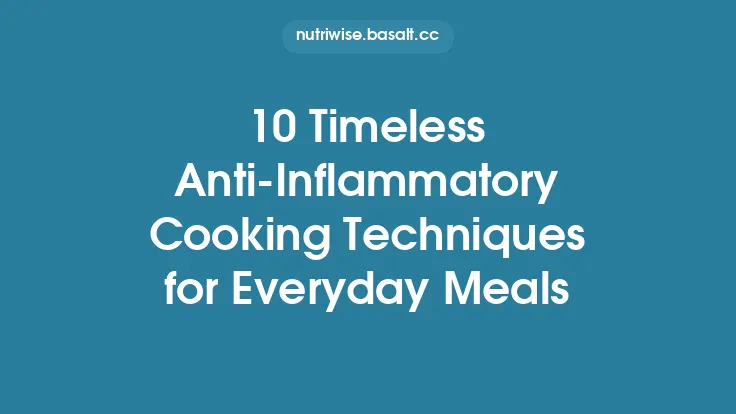Anti‑inflammatory eating often feels like a daily juggling act: you want to fill your plate with the right phytochemicals, omega‑3s, and antioxidants, yet the modern schedule rarely allows for meticulous, minute‑by‑minute cooking. Batch‑prep offers a practical bridge between nutritional science and real‑world constraints. By preparing large quantities of anti‑inflammatory foods in advance, you can lock in health benefits, reduce decision fatigue, and keep your kitchen running like a well‑oiled (or rather, well‑spiced) machine. The following guide walks you through the why, what, and how of batch‑prepping meals that consistently fight inflammation, while preserving flavor, texture, and nutrient potency.
Why Batch‑Prep Works for Anti‑Inflammatory Eating
- Consistent Nutrient Intake – When you have ready‑to‑eat portions of turmeric‑infused quinoa, roasted cauliflower, or omega‑3‑rich salmon, you’re less likely to skip meals or resort to processed convenience foods that are high in refined sugars and trans fats—both known inflammation triggers.
- Nutrient Stability – Certain anti‑inflammatory compounds (e.g., polyphenols in berries, curcumin in turmeric) are sensitive to prolonged exposure to heat, light, and oxygen. Batch‑cooking allows you to apply controlled cooking methods once, then store the food in airtight, low‑light containers, minimizing repeated heating cycles that degrade these bioactives.
- Economies of Scale – Buying staples like lentils, nuts, and frozen berries in bulk reduces cost per serving, making a nutrient‑dense diet more affordable. Bulk purchasing also ensures you always have the key anti‑inflammatory ingredients on hand.
- Time Efficiency – Consolidating prep into a single weekend session frees up weekday evenings for other priorities. The “cook‑once, eat‑many” model reduces daily kitchen cleanup and the mental load of deciding what to make each night.
- Portion Control – Pre‑measured containers help you stay within recommended caloric and macronutrient ranges, which is crucial because excess calories, even from healthy foods, can promote systemic inflammation.
Core Anti‑Inflammatory Ingredients to Stock
| Food Group | Representative Items | Anti‑Inflammatory Compounds | Storage Tips |
|---|---|---|---|
| Omega‑3‑rich proteins | Wild‑caught salmon, sardines, mackerel, chia seeds, hemp seeds, walnuts | EPA/DHA, ALA | Freeze fish in vacuum‑sealed bags; store seeds in airtight jars in the fridge to prevent rancidity |
| Phytonutrient‑dense vegetables | Leafy greens (kale, spinach), cruciferous veg (broccoli, Brussels sprouts), sweet potatoes, beets | Flavonoids, glucosinolates, beta‑carotene | Blanch and freeze for up to 12 months; keep fresh greens in a perforated bag with a damp paper towel |
| Legumes & whole grains | Red lentils, black beans, quinoa, farro, brown rice | Fiber, polyphenols, magnesium | Cook in bulk, portion, and freeze; dry beans store in a cool, dark pantry for years |
| Spice & herb arsenal | Turmeric, ginger, cinnamon, garlic, rosemary, oregano, black pepper | Curcuminoids, gingerols, cinnamaldehyde, phenolic acids | Keep in airtight containers away from heat; consider making a “anti‑inflammatory blend” for quick seasoning |
| Fruit & nuts | Blueberries, pomegranate seeds, almonds, pistachios | Anthocyanins, ellagic acid, vitamin E | Freeze berries on a tray before bagging; store nuts in the freezer to preserve healthy fats |
| Healthy fats | Extra‑virgin olive oil, avocado oil, avocado | Oleocanthal, monounsaturated fats | Store oil in dark glass bottles; keep avocado halves with a squeeze of lemon and wrap tightly |
Designing a Balanced Batch‑Prep Menu
A truly anti‑inflammatory menu balances macronutrients (protein, healthy fats, complex carbs) with micronutrients (vitamins, minerals, phytochemicals). Follow these steps:
- Set Macro Targets – For most adults, aim for 20‑30 % of calories from protein, 25‑35 % from healthy fats, and 40‑55 % from complex carbs. Adjust based on activity level and personal health goals.
- Select a “Base” – Choose 2‑3 carbohydrate bases that can be cooked in bulk (e.g., quinoa, brown rice, sweet‑potato cubes). These provide a neutral canvas for flavor variations.
- Add Protein Pillars – Cook a mix of plant‑based (lentils, chickpeas) and animal‑based (wild salmon, free‑range chicken) proteins. Season each batch differently to avoid monotony.
- Incorporate Veggie Medleys – Roast, steam, or pressure‑cook a rainbow of vegetables. Keep them separate so you can mix‑and‑match later.
- Create Flavor Boosters – Prepare a few signature sauces or dressings (e.g., tahini‑lemon, miso‑ginger, avocado‑cilantro) that are rich in anti‑inflammatory spices and healthy fats.
- Plan for Snacks – Portion out nuts, seed mixes, and fruit‑based energy bites that can be grabbed on the go.
- Balance Micronutrients – Use a spreadsheet or a nutrition app to ensure each day’s meals collectively meet recommended intakes for vitamin C, magnesium, zinc, and omega‑3s.
Time‑Saving Cooking Strategies
While the article’s neighboring pieces cover specific techniques, the following overarching strategies streamline bulk preparation without overlapping:
| Strategy | How It Works | Benefits for Anti‑Inflammatory Quality |
|---|---|---|
| Batch‑Cooking in Parallel | Use multiple appliances simultaneously (e.g., oven for roasting veg, stovetop for grains, pressure cooker for beans). | Reduces total cooking time; each method can be optimized for nutrient retention (e.g., pressure cooking preserves water‑soluble vitamins). |
| One‑Sheet Pan “Assembly” | Lay out protein, veg, and a drizzle of oil on a single sheet; roast everything together. | Minimizes handling, reduces oxidation of oils, and ensures uniform exposure to heat. |
| Pre‑Portioned “Ingredient Kits” | Assemble zip‑lock bags with measured raw ingredients (e.g., 1 cup quinoa, ½ cup broccoli, 4 oz salmon). | Quick to dump into a pot or microwave; reduces measurement errors and portion drift. |
| Rapid‑Cool Shock | After cooking, plunge containers into an ice‑water bath before sealing. | Stops residual cooking, preserving heat‑sensitive antioxidants like vitamin C and polyphenols. |
| Use of a Food Processor for Uniform Cuts | Slice or dice large batches of veg in seconds. | Uniform size ensures even cooking, which helps maintain consistent nutrient profiles across pieces. |
| Pre‑Made Spice Mixes | Blend anti‑inflammatory spices in bulk (e.g., turmeric‑cumin‑black‑pepper). | Guarantees the presence of piperine, which dramatically enhances curcumin absorption. |
Optimizing Nutrient Retention During Bulk Cooking
- Temperature Control – For heat‑sensitive compounds (e.g., vitamin C, folate), keep cooking temperatures below 180 °C (350 °F) when possible. Use moderate oven settings or gentle stovetop simmering for delicate vegetables.
- Minimal Water Use – Water‑soluble antioxidants leach into cooking liquids. When boiling beans or grains, retain the cooking broth and incorporate it into sauces or soups to recapture lost nutrients.
- Acidic Additions – Adding a splash of lemon juice or vinegar during cooking can stabilize anthocyanins in berries and improve the bioavailability of iron from plant sources.
- Fat Pairing – Many phytochemicals (e.g., curcumin, lycopene) are fat‑soluble. Cook or toss them with a modest amount of extra‑virgin olive oil or avocado oil to enhance absorption.
- Avoid Over‑Cooking – Over‑roasting can cause Maillard reactions that generate advanced glycation end products (AGEs), which are pro‑inflammatory. Aim for a tender‑crisp texture, especially for cruciferous vegetables.
- Use of Pressure Cooking – This method reduces cooking time dramatically (often <15 min for beans) while preserving B‑vitamins and antioxidants better than prolonged boiling.
Smart Storage and Shelf‑Life Management
| Food Type | Ideal Container | Recommended Shelf Life (Refrigerated) | Recommended Shelf Life (Frozen) |
|---|---|---|---|
| Cooked grains & legumes | BPA‑free plastic or glass containers with tight lids | 4‑5 days | 3‑4 months |
| Roasted vegetables | Single‑layer containers to avoid sogginess | 3‑4 days | 2‑3 months |
| Cooked fish or poultry | Vacuum‑sealed bags or airtight containers | 2‑3 days | 2‑3 months |
| Sauces & dressings | Small glass jars (≤250 ml) | 1‑2 weeks (if oil‑based) | 3‑4 months |
| Fresh herbs (chopped) | Ice‑cube trays with water or oil, then frozen | 5‑7 days (fridge) | 6‑12 months (frozen) |
| Nut & seed mixes | Vacuum‑sealed bags, stored in freezer | 1‑2 months (fridge) | 6‑12 months (freezer) |
Key Practices
- Label Everything – Include the date cooked, portion size, and a brief description (e.g., “Quinoa‑Broccoli‑Salmon, 1 cup”). Use waterproof markers or printable labels.
- Cool Before Sealing – Allow foods to reach room temperature (no longer than 2 h) before closing containers to prevent condensation and microbial growth.
- Rotate Stock – Adopt a “first‑in, first‑out” system. Place newly prepared meals at the back of the fridge/freezer and move older items forward.
- Avoid Cross‑Contamination – Store raw proteins on the bottom shelf of the fridge, separate from ready‑to‑eat meals.
Labeling, Portioning, and Rotation Systems
- Standardized Portion Units – Decide on a base serving size (e.g., 1 cup cooked grain, 4 oz protein, ½ cup veg). Use measuring cups or a digital scale to portion each container uniformly.
- Color‑Coding – Assign a color to each macronutrient group (e.g., green for veg, blue for protein, orange for carbs). Use colored stickers on lids for quick visual identification.
- Digital Inventory – Keep a simple spreadsheet or use a meal‑prep app to log each batch: date, contents, and expiration. Set reminders for “use by” dates.
- Meal‑Assembly Templates – Create a printable “plate guide” that shows how to combine portions (e.g., ½ plate veg, ¼ plate protein, ¼ plate carb). This reduces decision fatigue each day.
- Weekly Rotation – Plan a 7‑day cycle where each day’s main protein or veg changes. For example, Monday: salmon‑quinoa‑spinach; Tuesday: lentil‑farro‑roasted‑beets; etc. This ensures variety while still using the same bulk‑cooked components.
Integrating Batch‑Prep into a Busy Lifestyle
- Weekend “Prep‑Day” Blueprint – Allocate 2‑3 hours on Saturday morning. Begin with a quick inventory, then follow the parallel‑cooking schedule: start the pressure cooker, load the oven, and while those run, assemble spice mixes and portion snacks.
- Micro‑Prep Sessions – If a full weekend isn’t feasible, split tasks: cook grains on Sunday, roast veg on Wednesday, and assemble sauces on Friday. The key is to keep each session under 45 minutes.
- Portable Meal Packs – Transfer a day’s worth of portions into a single insulated lunch bag with an ice pack. This eliminates the need for reheating at work and preserves texture.
- Reheat Smartly – Use a microwave on medium power and stir halfway through to avoid hot spots that can degrade heat‑sensitive nutrients. For crisp textures, finish with a quick 2‑minute blast in a hot skillet (just enough to restore crunch without over‑cooking).
Common Pitfalls and How to Avoid Them
| Pitfall | Consequence | Solution |
|---|---|---|
| Over‑seasoning with Salt | Excess sodium can counteract anti‑inflammatory benefits. | Use herbs, spices, citrus, and umami‑rich ingredients (e.g., miso, nutritional yeast) instead of salt. |
| Storing in Non‑Airtight Containers | Oxidation of healthy fats leads to rancidity and loss of omega‑3s. | Invest in vacuum‑sealers or high‑quality airtight jars. |
| Re‑heating Multiple Times | Repeated heating degrades curcumin, flavonoids, and vitamin C. | Portion into single‑serve containers; heat only once before eating. |
| Neglecting Food Safety | Improper cooling can cause bacterial growth, negating health benefits. | Follow the 2‑hour rule for cooling, and keep fridge at ≤4 °C (40 °F). |
| Monotonous Flavor Profiles | Boredom leads to diet fatigue and eventual abandonment. | Rotate spice blends, vary cooking oils, and experiment with global flavor bases (e.g., Mediterranean, Southeast Asian). |
| Ignoring Portion Size | Over‑eating even healthy foods can increase inflammatory markers like CRP. | Use measured containers and track intake with a nutrition app. |
Sample 7‑Day Batch‑Prep Plan
> Note: All meals are designed for a 2,000‑calorie diet with ~30 % protein, 30 % fat, 40 % carbs. Adjust portion sizes as needed.
| Day | Breakfast | Lunch | Dinner | Snack |
|---|---|---|---|---|
| Mon | Overnight oats with chia, blueberries, cinnamon, almond milk | Quinoa‑salmon bowl: 1 cup quinoa, 4 oz baked salmon, ½ cup roasted broccoli, drizzle tahini‑lemon dressing | Lentil‑sweet‑potato stew (pressure‑cooked) with a side of sautéed kale (quick garlic‑olive‑oil) | Handful of walnuts + a few pomegranate seeds |
| Tue | Green smoothie: spinach, avocado, frozen mixed berries, hemp protein, ginger | Farro‑chickpea salad: farro, chickpeas, diced red pepper, parsley, olive‑oil‑apple‑cider‑vinegar | Grilled (medium‑heat) chicken thighs (marinated in rosemary‑garlic‑olive‑oil) with roasted carrots and a side of brown rice | Greek yogurt (plain) with a drizzle of honey and cinnamon |
| Wed | Scrambled eggs with turmeric, black pepper, and sautéed mushrooms | Mediterranean bowl: couscous, grilled halloumi, roasted eggplant, cherry tomatoes, basil‑pesto drizzle | Baked cod with a miso‑ginger glaze, served over a bed of wilted Swiss chard and quinoa | Apple slices with almond butter |
| Thu | Chia pudding (coconut milk, vanilla, topped with pistachios) | Turkey‑lentil chili (slow‑cooked batch) with a side of quinoa | Stir‑fried tofu (in avocado oil) with bell peppers, snap peas, and a ginger‑turmeric sauce | Dark chocolate (≥70 % cacao) + a few almonds |
| Fri | Buckwheat pancakes (flaxseed meal added) topped with warm berry compote | Salmon‑avocado salad: mixed greens, 4 oz cold‑smoked salmon, avocado, cucumber, lemon‑dill dressing | Spaghetti squash with a roasted tomato‑basil sauce and a sprinkle of nutritional yeast | Carrot sticks with hummus |
| Sat | Yogurt parfait: Greek yogurt, granola (low‑sugar), pomegranate, drizzle of maple syrup | Quinoa‑black bean bowl: quinoa, black beans, corn, cilantro, lime‑cumin dressing | Baked chicken breast with rosemary‑garlic rub, served with sweet‑potato mash and steamed green beans | Handful of mixed seeds (pumpkin, sunflower) |
| Sun | Smoothie bowl: acai, banana, spinach, topped with sliced kiwi and hemp seeds | Mediterranean grain bowl: barley, feta, olives, roasted red peppers, oregano‑olive‑oil drizzle | Shrimp and vegetable paella (using brown rice, saffron, peas, and bell peppers) | Fresh berries with a dollop of ricotta |
Prep Highlights for the Week
- Grains – Cook quinoa, farro, brown rice, and barley in a large pot; portion into zip‑lock bags (1‑cup servings) and freeze.
- Proteins – Bake salmon, chicken, and cod on sheet pans; store in individual containers with a drizzle of olive oil to keep moisture.
- Legumes – Pressure‑cook lentils and chickpeas; keep a bulk container for quick mixing.
- Veggies – Roast a mixed tray of broccoli, carrots, Brussels sprouts, and sweet potatoes; keep separate from greens to maintain crispness.
- Sauces – Prepare tahini‑lemon, miso‑ginger, and lime‑cumin dressings in small jars; add a pinch of black pepper to the turmeric‑based sauces to boost curcumin absorption.
- Snacks – Portion nuts, seeds, and fruit into snack bags; store a few in the fridge for freshness.
By following this structured approach, you’ll have a week’s worth of meals that consistently deliver anti‑inflammatory nutrients, keep your palate excited, and free up precious time for everything else that matters. Happy prepping!





